The UK is filled with monuments, some natural and others man-made. These following landmarks in England, Scotland and Northern Ireland mark our ancient history, artistic and architectural achievements and celebrate some of our national heroes. You may have heard of some of them, but others are less well-known.
What you can expect in this post:
*This site uses affiliate links and I may earn a small commission when you use my links and make a purchase without incurring an additional fee yourself.
Thank you for supporting this website. See my disclaimer page for more details.
A tour around some of the monuments in England
Visiting Silbury Hill, Wiltshire
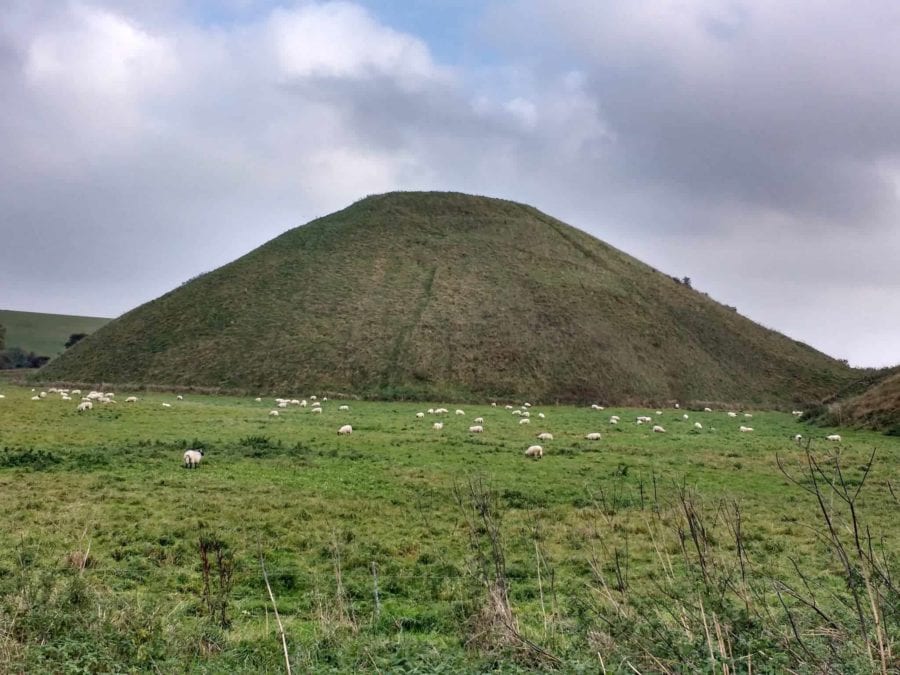
Contributed by Faith from XYU and Beyond & The World’s Kitchens
Silbury Hill is part of the UNESCO site of the Avebury World Heritage site. It is one of the most enigmatic monuments in Britain today. Higher than the pyramids this man made wonder stands over 130 feet tall.
It is estimated that Silbury Hill took over 400 million hours to build by our prehistoric ancestors. Despite many efforts to get to its secrets, the Hill remains a mystery and the source of many legends and myths. The Hill itself is built from tens of thousands of pounds of chalk and dirt and over generations more was added to it. The chalk and dirt was quarried from the surrounding ditch to build the mound.
What archaeologists do know is that the Hill was built during times of great change in Britain. Avebury Henge was built at the same time along with two large enclosures called West Kennet and East Kennet. This was a time of great construction works and work is still taking place trying to understand why these were built.
The Romans who came later and built a road and a large settlement at the foot of the mound also used Silbury. It is believed that during the medieval period, the hill was probably flattened and some kind of fort was placed on top.
Tunnels that were dug into the mound found nothing other than chalk. No burial chambers, no ceremonial items. The Hill remains a mystery to this day.
Clifton Suspension Bridge
Contributed by Heather from Heather on her Travels

The Clifton Suspension Bridge is one of Bristol’s most iconic landmarks and has come to be a symbol of the city, featuring on many a postcard, normally with a few hot air balloons drifting above it. The bridge sits 76 metres high above the river Avon, forming a gateway to the historic port of Bristol.
It was completed in 1863 and was designed and built by the famous Victorian engineer Isambard Kingdom Brunel, who also worked on the Great Western Railway and SS Great Britain. If you visit Bristol be sure to spend some time in the pretty Clifton village with its Georgian buildings that sits on one side of the bridge, before wandering across to admire the views over the Avon Gorge.
On the far side, you’ll find a free visitor centre with interesting information about the building of the bridge and the different designs that were submitted for the 1829 design competition, before Brunel’s was finally chosen.
The website will provide more information about the free weekend tours that are offered through the summer months and the little known hard hat tour that allows you to explore inside the stone vaults of the bridge. There are great views of the bridge to be found by climbing up to the Observatory that sits above the bridge, or from the terrace of the Avon Gorge Hotel, which is a popular spot for a drink on a sunny day. Read more about 25 fun things to do in Bristol.
Angel of the North
Contributed by Monique at TripAnthropologist

After many years of thinking about it, and being unsure about it, in just over 20 years the Angel of the North has become a beloved symbol of the north of England for the people of Newcastle. Standing on a low hill at Gateshead, Tyne and Wear, the Angel of the North is the largest statue in Britain and is the largest angel sculpture in the world.
You can’t miss the Angel of the North – its right beside the M1 Motorway at Low Eighton. There’s a car park you pull into and the statue is right there. There’s not fence, no entry fee, just a 20 meter high angel body with 54 meter wide wings! The Angel looks over a wide valley and can be seen for miles around.
The Angel is on a hill that it part of England’s industrial past where miners worked deep underground brought up the iron ore to make the great ships that were built in Newcastle. That’s why the Angel of the North is made of steel.
The status was designed by Antony Gormley who wanted the Angel to be a reassuring presence as the world moved out of the Industrial Revolution. There is something very endearing about this colossal statue and part of it is its lonely spot on the hill. There are no spotlights at night, so it’s best to visit on a sunny day and spend some time with the Northerners’ Angel.
Trafalgar Square, London
Contributed by Christina from Travel2next

One of the most stunning monuments in the UK is Trafalgar Square, which is an instantly recognisable place in Central London. Located in the City of Westminster, Trafalgar Square is one of the most famous London landmarks and everyone needs to visit. The public square is often used as a place for events and rallies, but it is also within walking distance of the National Gallery, museums, and other historic buildings you can visit.
Between the 14th to 17th centuries, a large part of the area was the courtyard of the Great Mews stabling of Whitehall Palace. In 1812, architect John Nash began planning a new street from Charing Cross to Portland Place and a cultural space for the public.
Then the famous Nelson’s Column, designed by William Railton, was added in 1843 followed by the fountains with mermaids, dolphins and tritons (mythological figures that are half man and half fish). Most visitors have their photos snapped in front of the bronze lions that guard the base of Nelson’s Column.
Trafalgar Square is a popular place, and you’ll often see locals and visitors eating lunch in front of the fountains. There’s café on the square at the bottom of the staircase.
How to get to Trafalgar Square: The closest tube station is Charing Cross, which is on the Bakerloo and Northern lines or you can also walk from Leicester Square, Piccadilly Circus or Embankment.
Monument to the Great Fire of London
Contributed by Greta from London Dreaming

Monument to the Great Fire of London, usually referred to just as Monument, is an important UK monument. It’s located in the heart of central London, just a few minutes walk away from Bank tube station.
It’s a Doric column 62 metres tall, built on the spot where St Margaret church used to stand, the first church to be destroyed by the Great Fire of London in 1966. Monument was built between 1671 and 1677.
There is a spiral staircase that leads to the top of Monument from which you can enjoy beautiful views over London. I love it because it’s high enough to see above the rooftops of the surrounding buildings, but not so high that you would lose some of the details.
The climb up is 311 steps. It feels like forever as you’re climbing but don’t let it dishearten you, the view is definitely worth it!
You will get a 360 view including St Paul’s Cathedral, the Shard, Tower Bridge, the City and even Canary Wharf in the distance. Entrance is £4.50 for adults, £3 for students and seniors and £2.30 for children.
The monument is one of the most iconic landmarks in London, and a must on any UK monument bucket list.
Tower Bridge
Contributed by Jiayi from The Diary of a Nomad
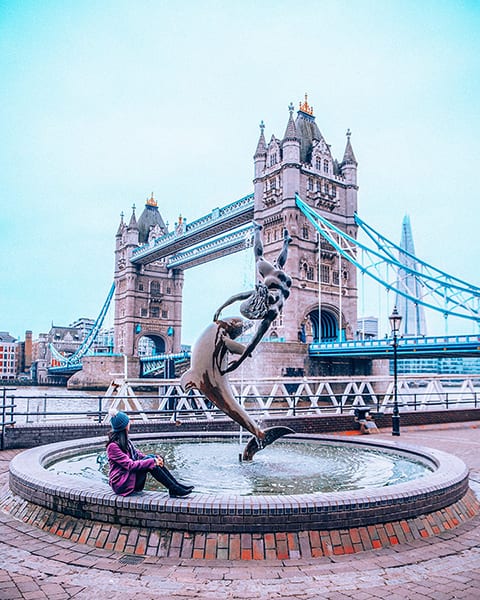
Located in the Southwark and Tower Hamlets boroughs of London, the incredible Tower Bridge is an iconic symbol of the city. Because of this, it often gets confused with London Bridge, which is actually 0.8 km away.
Tower Bridge is not only one of the most photogenic places in London, but it also has a remarkable history. Built between 1886 and 1894, it was designed to ensure that traffic in the river doesn’t get disrupted. Over 400 construction workers worked day and night to build it, and when it was completed, it became the world’s largest bascule bridge ever.
Tower Bridge crosses the Thames and is very close to the Tower of London. The nearest underground tube stations are Tower Hill (on the Circle and District lines), Bermondsey (on the Jubilee line), and London Bridge (on the Jubilee and Northern lines). There are no entrance fees for walking on the bridge.
When you’re there, make sure to stop by a fountain near the northern entrance of the bridge called ‘Girl with a Dolphin Fountain’. The view of the bridge from that spot is really cool, and it makes for a great photo op too!
I also recommend visiting Tower Bridge early in the morning to enjoy it without the massive crowds you’ll inevitably come across during the day.
Stonehenge, Wiltshire
Contributed by Darek from Darek and Gosia
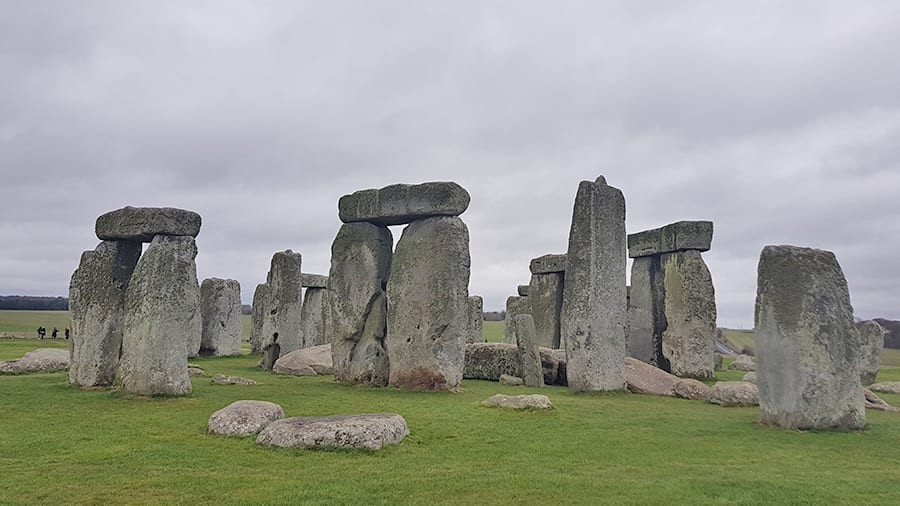
The United Kingdom is full of stunning places and amazing monuments. Many of those are located in England and can be visited on a short visit to the country.
Featured on many postcards, Stonehenge is one of the most famous buildings in England and you can also say that it is almost its symbol! This stone circle located 13 km from Salisbury has been the subject of many discussions for years, and in 1986 it was included on the UNESCO World Heritage List.
Its location is also the reason why this is a place that attracts many tourists – because it is perfect for a day trip from the capital city.
If you are going on a day trip from London, it is worth spending one day visiting this ancient circle – it only takes just under 2 hours drive from the capital of England. To get there, you have several options to choose from. The easiest is to use one of the local tourist agencies but you can also hire a car and drive there yourself.
Some visitors say that Stonehenge is disappointing it is just a pile of stones. Whether you like it or not this is definitely one of the most famous monuments in the United Kingdom.
Hadrian’s Wall
Contributed by Wendy from The Nomadic Vegan
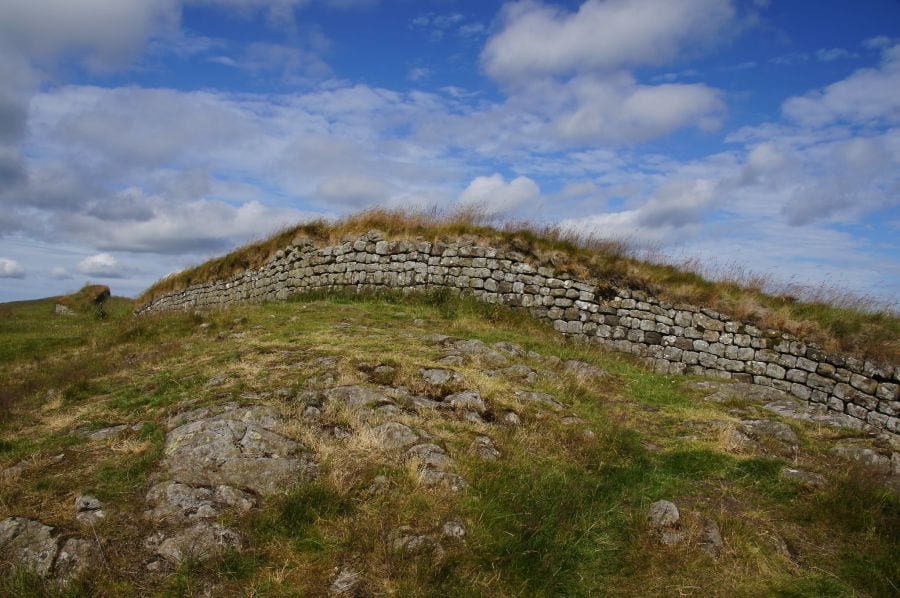
Hadrian’s Wall runs almost all the way across the north of England, virtually from coast to coast. Although technically, the easternmost point is a few miles inland at a town named, for obvious reasons, Wallsend.
Most of the wall runs through open countryside, and thus there is no entrance fee to visit. You are free to cycle or hike alongside Hadrian’s Wall for as long as you like. However, there are various forts, “milecastles” and museums that you can visit along the way, and some of these attractions do have entrance fees. It would take six to seven take to walk the full 84-miles, but you can also break it up and cover a shorter stretch.
Hexham makes a good base for visiting the wall, as there are several places of interest to see around here, including Housesteads Fort, Chester’s Fort, and one of the best-preserved milecastles, known as Milecastle 42.
The hop-on-hop-off AD 122 bus makes it easy to get from one attraction to the next, or if you have the time you can simply hike between them. As you may have guessed, the number of the bus refers to the date when the wall was built on the orders of Roman Emperor Hadrian. As the most famous Roman site in the UK, it’s certainly not to be missed.
Edith Cavell Monument, Norwich
Contributed by Jeremy from Cultura Obscura

Of the many memorials and places of dedication to Edith Cavell, the statue in Norwich holds the most personal significance as Norwich was her home city. The bust, with a carving of a soldier laying a wreath carved into the plinth, is one of the more subtle yet powerful of Norwich’s attractions.
Born and raised in East Anglia, Cavell trained as a nurse after caring for her father through a serious illness towards the end of the 19th century. She established herself in Belgium, and when the First World War broke out and Belgium became occupied by the Germans, she began sheltering British soldiers and helping them escape the country.
Once she was discovered by the Germans following her activities, she was tried, sentenced and finally executed by firing squad on the 12th of October 1915. Her death caused an international outcry – many saw her as following the true nature of medical care as while working as a nurse she was notable for saving lives on both sides of the conflict without discrimination. She is even commemorated in the Church of England Calendar of Saints on the date of her execution.
The Norwich monument to Cavell is located in the city centre, just outside the grounds of Norwich Cathedral, and very close to Cavell’s actual grave, which was renovated on her centenary in 2015. The monument is on public ground and therefore free to visit, and lies opposite a pub that also bears her name, in one of the most popular places to visit in Norwich known as Tombland.
A tour around some of the monuments in Scotland
Calton Hill in Edinburgh
Contributed by Gemma from Two Scots Abroad
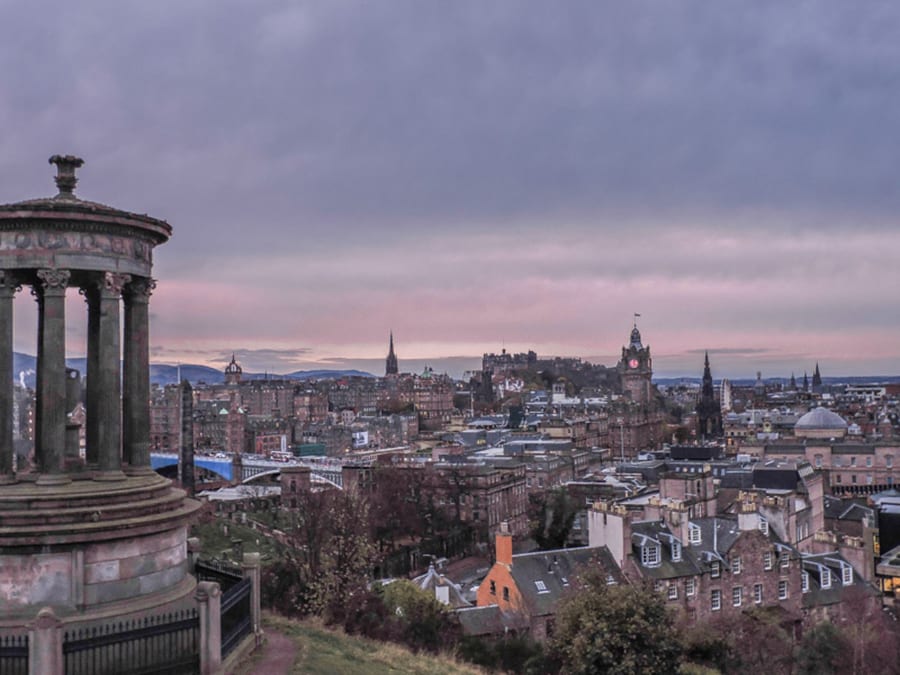
There is no shortage of monuments in Scotland’s capital, but why only see one when you can access three in the same place? Just one of the many free things to do in Edinburgh.
Edinburgh’s Calton Hill is home to the National Monument of Scotland, Nelson Monument and the lesser-known but often photographed, Dugald Stewart Monument.
The National Monument of Scotland is the most prominent. It is a 12 pillar stone Parthenon which kids love to climb. This monument was never completed. Did you know that Edinburgh is often called the Athens of the North?
The Nelson Monument is the tall one that looks like an upside-down telescope. Like many other monuments around the UK with the same name, it was built to celebrate the life of Vice-Admiral Horatio Nelson. Nelson’s most popular claim to fame was his victory at the battle of Trafalgar on 21 October 1805, where he died. His lesser-known shame was his support of the transatlantic slave trade which he fiercely argued to continue.
Visitors can pay to climb the 147 steps to see views of the city from the top.
The final monument on Calton Hill is the Dugald Stewart Monument. This one features in lots of landscape photographs as it is located on the same side of the city as Princes Street and Edinburgh Castle.
To get up to Calton Hill, enjoy the short hike up the pedestrianised area which starts at Regent Road on the Southside or Royal Terrace on the Northside.
John Rae Monument, Stromness, Orkney
Contributed by Suzanne from Meandering Wild
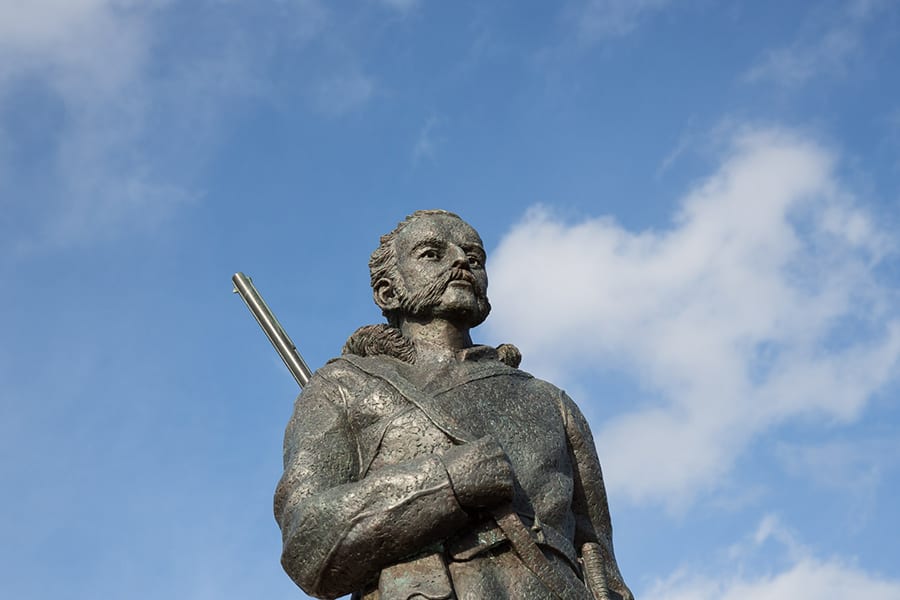
In the far north of Scotland, 8 miles offshore from John O’Groats are the Orkney Islands. These islands are reached by ferry or a short flight and as you arrive from Scrabster on the ferry the peaceful small town of Stromness is the first place you will visit. Right on the harbourside is a small statue, surrounded by the usual items associated with a working fishing port and ferry terminal.
This statue is to remember the life of Dr John Rae, an Orcadian doctor and explorer who was born just outside Stromness in a hamlet called Clestrain in 1813. In 1846 he became an explorer with the Hudson Bay Company, travelling to the Canadian Arctic numerous times.
During his expeditions from Stromness to the Arctic, he travelled 3645 miles by foot and 6700 miles by boat, a huge distance at the time. In 1854 he discovered the Rae Strait, the final and most important link in the North-West Passage between the Atlantic and Pacific Oceans.
In addition to the monument which was unveiled on his 200th birthday in 2013, the nearby Stromness Museum has artefacts from his expeditions that helps bring his travels to life. The artefacts include the clothing and boats they used as well as trinkets carved from bone and Inuit handicrafts. The museum costs £5 for entry but the monument is free to visit at any time.
Mary Barbour Statue, Glasgow
Contributed by Kathi from Watch Me See
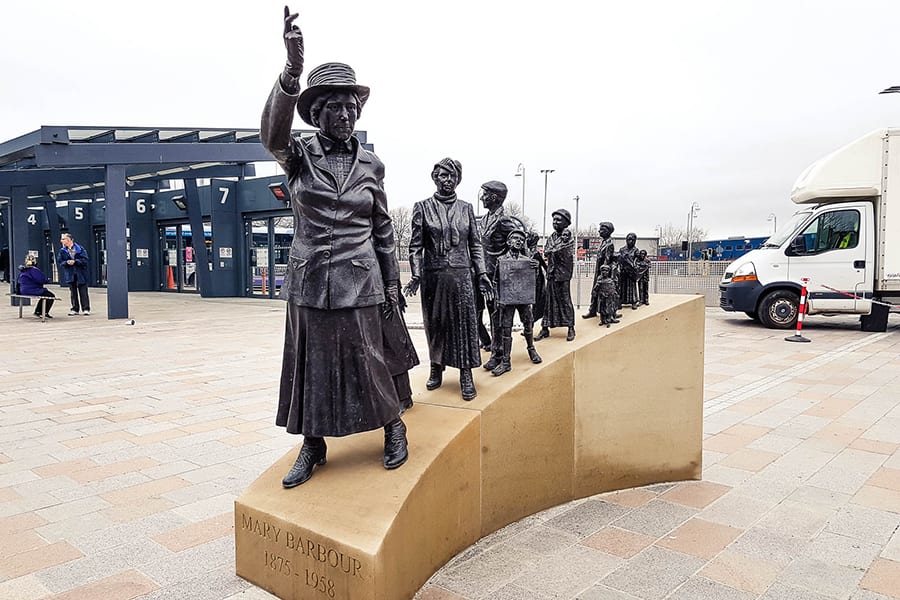
There are hundreds of statues all over Glasgow and while many of them are dedicated to men, there are only 4 statues that commemorate historic women. One of them – the latest to be erected – shows the local political activist Mary Barbour.
Mary Barbour was a Glaswegian suffragette but is mostly known for her leadership in the 1915 Glasgow rent strikes. The beginning of the first World War saw a massive influx of people moving to Glasgow to work in the local shipyards and factories. This caused landlords to raise rents and evict everyone who could not keep up with the payments.
Barbour, who lived in Govan, a residential working-class neighbourhood south of the River Clyde, organised the people who were affected to resist these changes. She organised protests and a rent strike. She set up the South Govan Women’s Housing Association and by the end of 1915, 20,000 tenants had joined the strike. Eventually, the city passed the Rent Restrictions Act to protect tenants from rent increases. Later on, Barbour founded the Women’s Peace Crusade and became one of the first woman councillors to the Glasgow Town Council.
The statue, which shows Barbour leading a group of men, women and children in protest, is located on Govan Road outside Govan subway station. It is one of many feminist sites in Glasgow.
The other statues of women in Glasgow are of Queen Victoria (George Square), philanthropist Isabella Elder (Elder Park, Govan) and Spanish freedom fighter Dolores Ibarruri (Clyde Street).
William Wallace in the Borders
Contributed by Larch from The Silver Nomad

There are several statues of William Wallace dotted around Scotland, but the first one erected was in 1814, near the ruins of Dryburgh Abbey in the Borders.
Sir William Wallace was the 13th Century Scottish hero who bravely fought the English at Stirling to try to gain Scottish independence.
The sandstone statue is 21.5 feet stands on a plinth 9.5 feet high and looks out over the River Tweed towards the Eildon Hills in the distance. The statue was commissioned by David Stewart Erskine, the 11th Earl of Buchan and was completed by John Smith, a self-taught sculptor from nearby Darnick.
There is a parking area on the B6356 just north of Dryburgh (satnav: TD6 9DP). From there it is about a 5-minute walk through the woods to the statue and the amazing views.

Sir Walter Scott Monument in Edinburgh
Contributed by Stephanie from The World As I See It
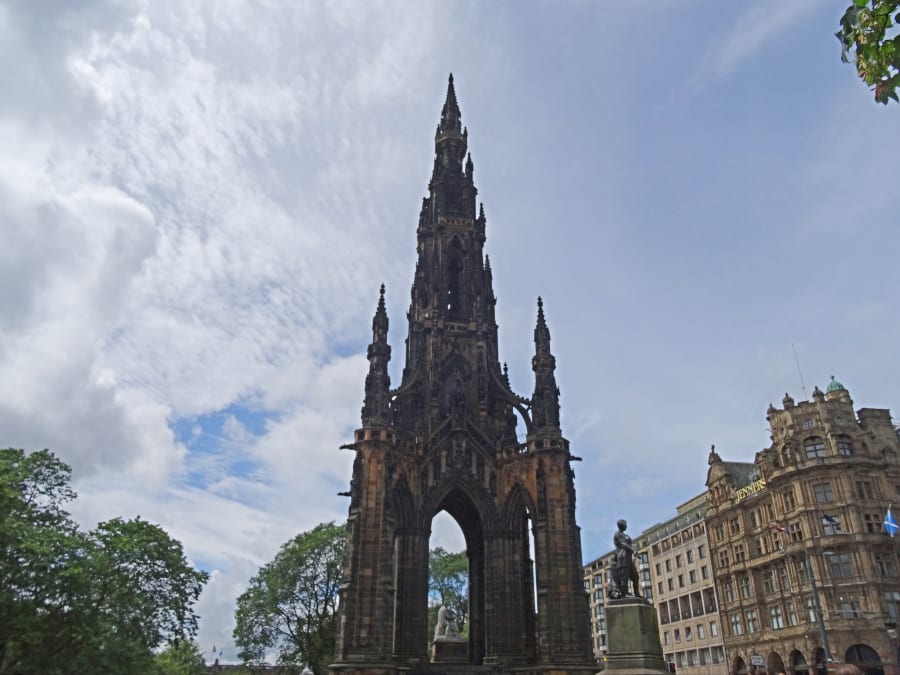
If you’re looking for an incredible UK monument to visit then check out Edinburgh’s Sir Walter Scott Monument. Walter Scott was a brilliant and famous Scottish writer from the early 19th century who is even noted for being the Father of Scottish Tourism. And his monument should be added to any UK book lovers’ itinerary.
The Scott monument is located in the heart of Edinburgh, on Princes Street in the Princes Street Gardens near Waverley Railway Station, which is also named after his novels. While statues of Scott can be found throughout Scotland, this one is not only the largest in Scotland but it’s also one of the largest monuments to a writer in the world.
Standing 200 feet (61 meters) tall, the Scott monument is a giant Victorian Gothic spire that was completed in 1844. Within its pillars sits a statue of Sir Walter Scott that’s carved out of Carrara marble and weighs 30 tons. In the monument is a small museum dedicated to his life and works. And for those looking for epic views, for eight pounds you can ascend the nearly 300 stairs within to a viewing platform and take in sweeping views over Edinburgh.
A tour around some of the monuments in Northern Ireland
Giant’s Causeway
Contributed by Krystianna from Volumes and Voyages
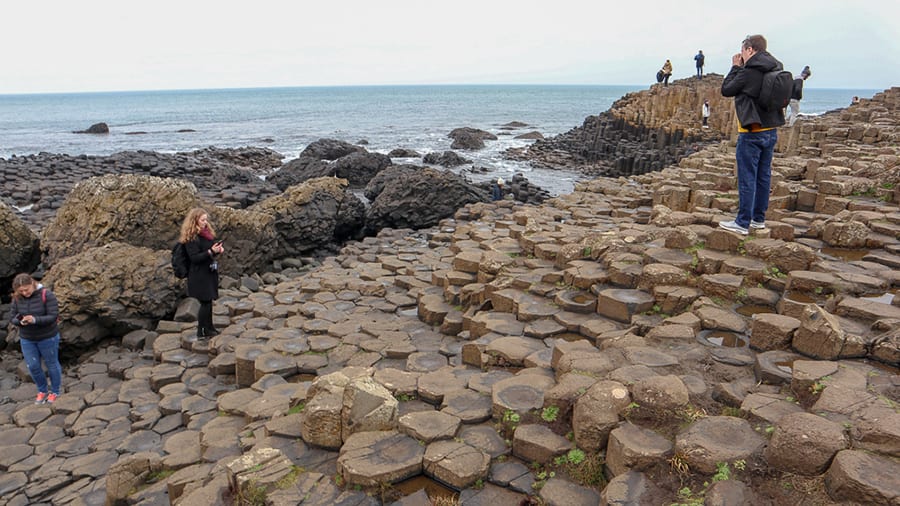
The Giant’s Causeway is a UNESCO World Heritage Site located in Bushmills, Northern Ireland in the UK. It’s one of those few sites you’ll visit in real life that you won’t believe is actually real! The site itself is made up of a bunch of tall rock columns that were all formed naturally.
That is, unless you believe the legend… a giant named Finn McCool was fighting with a giant across the water in Scotland. They were originally going to build a rock bridge between the two countries, yet a fight ensued and it was all ripped apart. Now, there’s an almost identical site in Scotland called Fingal’s Cave! You can learn more about this awesome legend during your trip to Giant’s Causeway.
Tickets for the Giants Causeway are as follows: adults for £13.50, children for £6.75, and anyone under 5 is free. You can purchase tickets online too for a slightly discounted price. The best way to get to Giant’s Causeway is either to rent a car or take a day trip from Belfast. I recommend checking out the Game of Thrones day tour, which included admission into this site and a bunch of other ones, all of which I was able to see in just one day.
The Peace Walls, Belfast
Contributed by Bradley from Dream Big, Travel Far

Located in Belfast, the peace walls indicate a significant part of Irish history. It’s been 22 years since the troubles have ended up in Northern Ireland (with the signing of the Good Friday Agreement in 1998) and these peace walls run throughout the city separating suburbs that are predominantly nationalist and unionist. They run for almost 30 km.
The peace walls are painted with various murals which signify the political views and history of Northern Ireland’s troubles. It’s free to see the peace walls in Belfast, but a popular way to see them is via a black taxi tour. This is typically run by someone who has a direct history with the troubles in Northern Ireland, so they’re able to give you some context and tell you the stories behind the murals. However, if you want to visit yourself, just pop in an Uber or catch the bus to Cupar Way and start your walking!
The most famous peace wall areas in Belfast city include those of “The Falls” & “The Shankill” which are located in west Belfast and they indicate two very contrasting political and cultural views. It’s a fascinating place to visit, and a great way to immerse yourself in the history of Northern Ireland.
Carrick-a-Rede Rope Bridge
Contributed by Krystianna from Volumes and Voyages
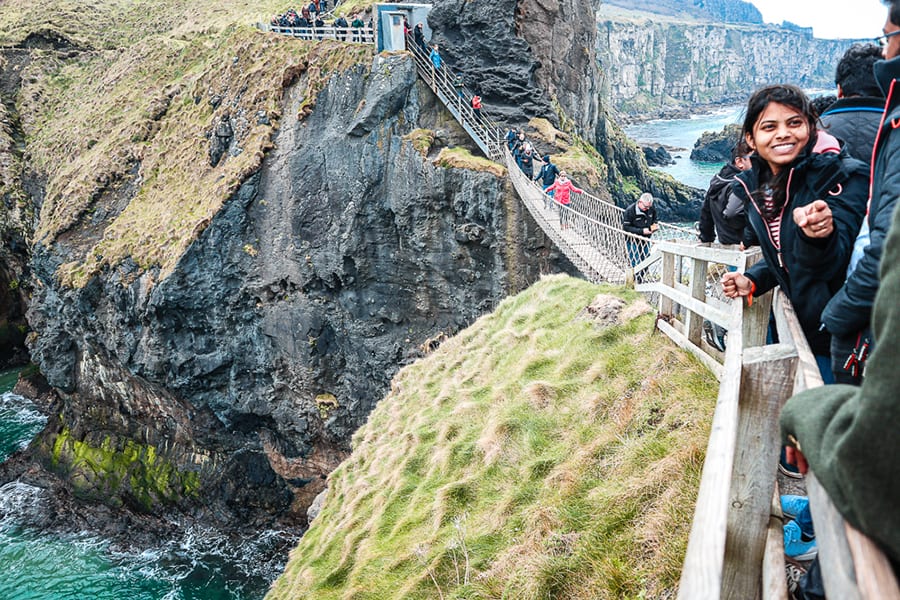
If you’re exploring Northern Ireland, then you absolutely must visit Carrick-a-Rede Rope Bridge. It’s located in County Antrim near Ballintoy. This bridge was built over 200 years ago and was used by fishermen who were trying to catch salmon.
The bridge itself is actually about 20 meters long, and it moves a lot if you visit on a windy day! Trust me, crossing the bridge is not for someone who is scared of heights at all. In fact, I’m not scared of heights and even I was gripping the rope while crossing over the bridge!
The two easiest ways to get to Carrick-a-Rede Rope Bridge are to either take a day tour from Belfast or rent a car. It’s not easily accessed by public transportation since it’s not in a super busy area, unfortunately. However, I still highly recommend that you at least make the trip there. The views are breathtaking, and it’s free to visit unless you decide to cross the bridge. It costs £10 for adults and £5 for children.
Don’t forget to pin this article so you can come back to it later


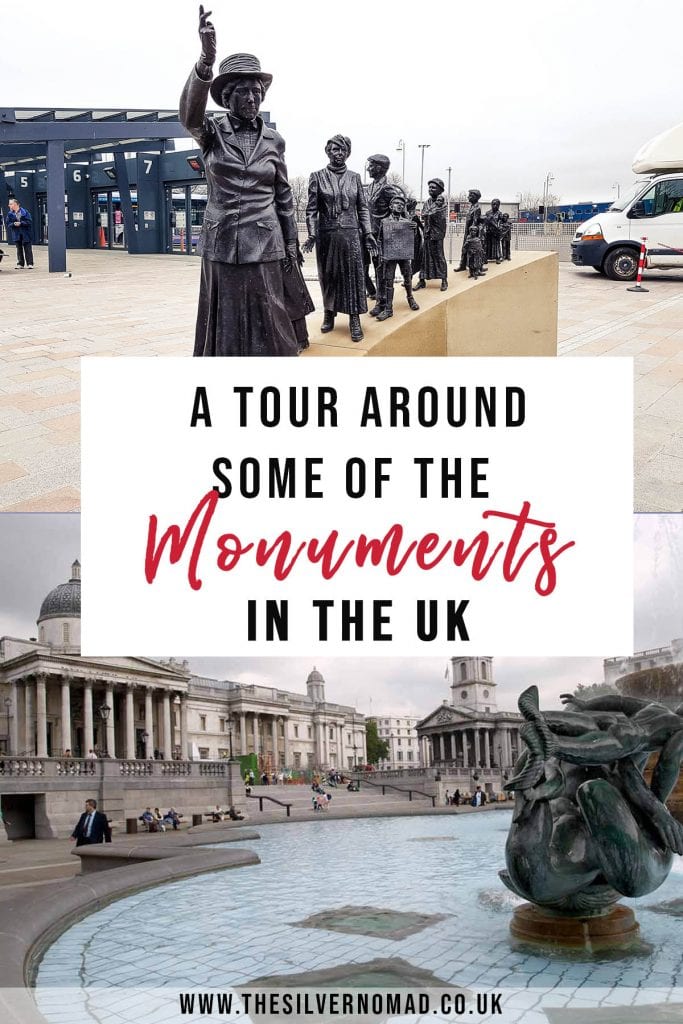


The UK is filled with incredible history and stunning architecture! ????This list of 17 amazing monuments is a fantastic guide for anyone looking to explore the rich heritage of the UK. Thanks for sharing these must-see spots! ????
Thank you
This is such a fantastic list. I have to say that Stonehenge is perhaps one of my all time favorites and I cannot wait to visit that when all this travel ban is lifted. What a experience to be a part of history each of these places represents!
Stonehenge is magnificent and such a atmospheric place to visit. I hope you get there soon.
It is sad to admit that much of our visit to the UK has been to the bigger cities. So interesting to see the monuments spread out around the country in the UK. The monuments all look so different and unique. And memorialize such important times in UK’s history. Definitely some new spots to travel on our next trip to the UK.
I hope you get to travel soon, Linda.